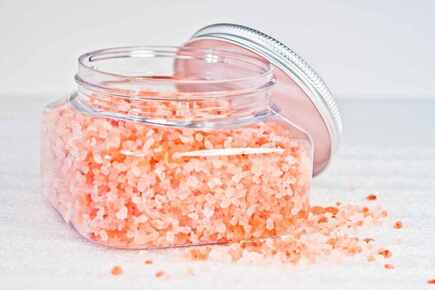Salt plays an essential role in life. It helps maintain human health, preserve food, and flavor meals. Salt contains different minerals such as sodium chloride, calcium, manganese, and sulfates, has anti-bacterial and anti-inflammatory properties, and it's a good source of negative ions.
History of salt
Salt was a highly valued trade product, a great source of revenue, and even was considered a form of currency called “white gold” in some countries. There are three methods of salt production: mining, evaporation from seawater, and creating salt brines. The earliest salt production place in the world was found in Romania, dating from approximately 6,000 BC.
In the 4th century, a big salt deposit was accidentally discovered by the army of Alexander the Great in Pakistan. However, the mining of salt there, well-known as Himalayan pink salt, started only in 1200. Today, the Khewra salt mines are the second largest in the world. Salt production in China started on a large scale at the beginning of 1600 BC during the Shang Dynasty.
In the 4th century, a big salt deposit was accidentally discovered by the army of Alexander the Great in Pakistan. However, the mining of salt there, well-known as Himalayan pink salt, started only in 1200. Today, the Khewra salt mines are the second largest in the world. Salt production in China started on a large scale at the beginning of 1600 BC during the Shang Dynasty.
Exploring salt therapy
Hippocrates believed that salt therapies could provide relief for respiratory conditions. Polish doctor Feliks Boczkowski was a pioneer in researching salt healing properties. He noticed that salt miners from the Wieliczka salt mine were healthier than other people and didn’t have any respiratory health issues.
He discovered that the unique micro-climate and salty air helped keep their lungs free from infection and allergies. Dr. Boczkowski opened the first underground health facility in 1836. Nowadays, Wieliczka salt resort has become a favorite health center for those who want to ease and cure their health conditions.
He discovered that the unique micro-climate and salty air helped keep their lungs free from infection and allergies. Dr. Boczkowski opened the first underground health facility in 1836. Nowadays, Wieliczka salt resort has become a favorite health center for those who want to ease and cure their health conditions.
Benefits of salt therapy
Salt therapy is an alternative non-invasive and drug-free treatment. There is scientific evidence regarding salt therapy's proven effectiveness in preventing and curing respiratory and skin diseases.
Treatment is recommended for various diseases, including bronchitis, bronchial asthma, sinusitis, tonsillitis, eczema, psoriasis, acne, dermatitis, allergy rash, pharyngitis, multi-chemical sensitive syndrome, rhinitis, respiratory allergies to pollutants, frequent viral infections, smoker’s cough, chronic obstructive pulmonary disease, breathlessness, chest tightness, weakened immunity, and more.
Salt therapy has overall health benefits such as helping remove toxins from a body, reducing diabetes risk, balancing PH in blood, supporting digestion, heart health, and blood pressure.
Treatment is recommended for various diseases, including bronchitis, bronchial asthma, sinusitis, tonsillitis, eczema, psoriasis, acne, dermatitis, allergy rash, pharyngitis, multi-chemical sensitive syndrome, rhinitis, respiratory allergies to pollutants, frequent viral infections, smoker’s cough, chronic obstructive pulmonary disease, breathlessness, chest tightness, weakened immunity, and more.
Salt therapy has overall health benefits such as helping remove toxins from a body, reducing diabetes risk, balancing PH in blood, supporting digestion, heart health, and blood pressure.
Duzdag Physiotherapy center
What is speleotherapy?
Speleotherapy is one type of salt therapy that takes place inside the natural underground salt mines. What makes the salt mine an ideal therapeutic environment for specific illnesses treatment? There are three main reasons:
1. A stable micro-climate throughout the year with a favorable humidity level and temperature.
2. Absence of pathogenic microorganisms and allergens in the air.
3. A unique micro climate where the air is saturated with aerosol consisting of Na, Ca, and Mg ions.
Speleotherapy today is a recognized and effective method of treatment. The important role in the implementation of speleotherapy therapeutic effect is physical and chemical environmental parameters. The therapeutic properties of the underground environment differ between salt mines. Furthermore, air properties within the same mine may be different.
When salt aerosol particles are inhaled, they go to the lung and help relieve inflammation, open up the airways, increase oxygen intake, and cleanse the airways from smoke, dust, pollutants, and allergens. Mobility and deep breathing help the healing process. Medical experts recommend speleotherapy procedures for 14– 18 days long for adults and 7–10 days for children over 1-year-old. It is preferred to perform two treatments per year.
Today some salt mines in Europe and Asia are used for therapeutic and recreational purposes. However, many countries still didn't want to recognize the health benefits of speleotherapy. Numerous scientific studies confirmed the effectiveness of salt therapy (see references below).
Due to the significant growth of allergic respiratory diseases in Europe speleotherapy has raised a special interest. The Eastern European countries, such as Belarus, Ukraine, Poland, Romania, Germany, etc., have been using this type of treatment for decades. The curative speleotherapy treatment is covered by the public health system in some European countries.
1. A stable micro-climate throughout the year with a favorable humidity level and temperature.
2. Absence of pathogenic microorganisms and allergens in the air.
3. A unique micro climate where the air is saturated with aerosol consisting of Na, Ca, and Mg ions.
Speleotherapy today is a recognized and effective method of treatment. The important role in the implementation of speleotherapy therapeutic effect is physical and chemical environmental parameters. The therapeutic properties of the underground environment differ between salt mines. Furthermore, air properties within the same mine may be different.
When salt aerosol particles are inhaled, they go to the lung and help relieve inflammation, open up the airways, increase oxygen intake, and cleanse the airways from smoke, dust, pollutants, and allergens. Mobility and deep breathing help the healing process. Medical experts recommend speleotherapy procedures for 14– 18 days long for adults and 7–10 days for children over 1-year-old. It is preferred to perform two treatments per year.
Today some salt mines in Europe and Asia are used for therapeutic and recreational purposes. However, many countries still didn't want to recognize the health benefits of speleotherapy. Numerous scientific studies confirmed the effectiveness of salt therapy (see references below).
Due to the significant growth of allergic respiratory diseases in Europe speleotherapy has raised a special interest. The Eastern European countries, such as Belarus, Ukraine, Poland, Romania, Germany, etc., have been using this type of treatment for decades. The curative speleotherapy treatment is covered by the public health system in some European countries.
References
1. H Lăzărescu,* I Simionca,* M Hoteteu,* and L Mirescu* "Speleotherapy - modern bio-medical perspectives". Journal of Medicine and Life. 2014
2. Sylwia Mętel, Magdalena Kostrzon, Justyna Adamiak, Halina Gattner, Dominika Kościelecka, Angelika Sosulska, Elżbieta Szczygieł and Joanna Golec "The influence of speleotherapy combined with pulmonary rehabilitation on functional fitness in older adults - preliminary report". Sage Journal. Therapeutic Advances in Respiratory Disease. 2020
3. C. Munteanu. "Speleontherapy - scientific relevance in the last five years (2013-2017) - A systematic review". Balneo Research Journal. 2017
4. Eslaminejad A, Taghavi K, Zohal, M, Kialashaki M, Fakharian A. "Speleotherapy as an effective treatment of chronic obstructive pulmonary disease". Journal of Respiratory Medicine and Lung Disease. 2017
1. H Lăzărescu,* I Simionca,* M Hoteteu,* and L Mirescu* "Speleotherapy - modern bio-medical perspectives". Journal of Medicine and Life. 2014
2. Sylwia Mętel, Magdalena Kostrzon, Justyna Adamiak, Halina Gattner, Dominika Kościelecka, Angelika Sosulska, Elżbieta Szczygieł and Joanna Golec "The influence of speleotherapy combined with pulmonary rehabilitation on functional fitness in older adults - preliminary report". Sage Journal. Therapeutic Advances in Respiratory Disease. 2020
3. C. Munteanu. "Speleontherapy - scientific relevance in the last five years (2013-2017) - A systematic review". Balneo Research Journal. 2017
4. Eslaminejad A, Taghavi K, Zohal, M, Kialashaki M, Fakharian A. "Speleotherapy as an effective treatment of chronic obstructive pulmonary disease". Journal of Respiratory Medicine and Lung Disease. 2017





